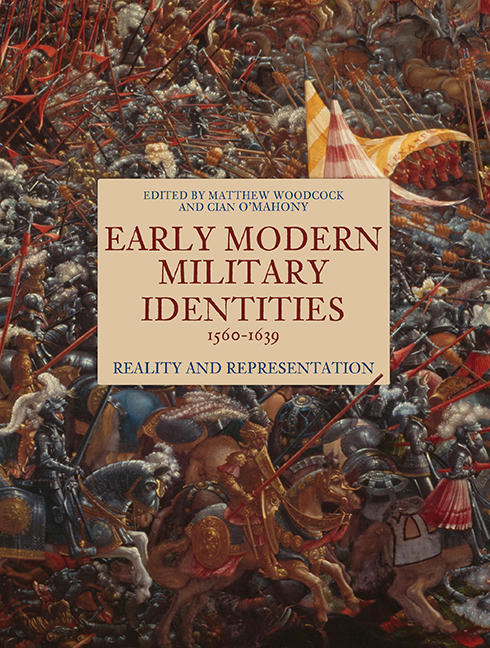Book contents
- Frontmatter
- Contents
- List of Illustrations
- List of Contributors
- Acknowledgments
- List of Abbreviations
- Introduction
- Part I Models of Military Identity
- Part II Military Identities in Early odern Ireland
- 5 The Clergy and the Military in Early Modern Ireland
- 6 ‘Trust, Desert, Power and skill to serve’: The Old English and Military Identities in Late Elizabethan Ireland
- 7 Artifice in Ormonius: Why a Renaissance Latin Epic Falsified the Military History of a Tudor Irish General
- 8 Irish Savage and English Butcher: Military Identities and Tyrone's Rebellion, 1593-1603
- 9 A print in my body of this day's service’: Finding Meaning in Wounding During and After the Nine Years War
- Part III Staging Military Identities
- Afterword: The Way Ahead
- Bibliography
- Index
9 - A print in my body of this day's service’: Finding Meaning in Wounding During and After the Nine Years War
from Part II - Military Identities in Early odern Ireland
Published online by Cambridge University Press: 14 September 2019
- Frontmatter
- Contents
- List of Illustrations
- List of Contributors
- Acknowledgments
- List of Abbreviations
- Introduction
- Part I Models of Military Identity
- Part II Military Identities in Early odern Ireland
- 5 The Clergy and the Military in Early Modern Ireland
- 6 ‘Trust, Desert, Power and skill to serve’: The Old English and Military Identities in Late Elizabethan Ireland
- 7 Artifice in Ormonius: Why a Renaissance Latin Epic Falsified the Military History of a Tudor Irish General
- 8 Irish Savage and English Butcher: Military Identities and Tyrone's Rebellion, 1593-1603
- 9 A print in my body of this day's service’: Finding Meaning in Wounding During and After the Nine Years War
- Part III Staging Military Identities
- Afterword: The Way Ahead
- Bibliography
- Index
Summary
In October 1600 Lord Deputy Mountjoy attempted to lead his army into Ulster via the Moyry Pass, a route strongly fortified and defended by the troops of Hugh O'Neill, earl of Tyrone. According to the Annals of the Four Masters, O'Neill sent forth
fierce and energetic bands of soldiers against him, like unto swarms of bees issuing from the hollows of bee-hives. They proceeded to wound, pierce, hew, and hack them, so that they were compelled to return back […] to the camp, after the killing of countless numbers of their gentlemen, officers, recruits, and attendants.
In sixteenth-century Ireland, few soldiers and commanders who served for any length of time escaped being wounded; neither could they escape wounding others. Those snatches of combat that are recorded in the Irish annals, State Papers and other sources routinely tell of flesh-piercing, bone-crunching encounters.
Reading wounds
The late Elizabethan Irish wars generated a growing level of violence between soldiers and towards civilians. Casualty levels were increased by mindsets that characterised enemies as ‘Irish rebels’ or ‘English churls’, and that legitimised atrocity as a means of dealing with opposition cheaply and definitively. Advances in tactics and weapons had a significant impact on the means of killing and wounding by the end of the sixteenth century: the large numbers of gunshot wounds reported in the State Papers in the 1590s provides one indication of how warfare in Ireland had been affected by the spread of the ‘military revolution’. James O'Neill's research on the Nine Years War demonstrates how Tyrone had modernised his army, creating a ‘hybrid force that combined the advantages of modern firepower-oriented infantry with the flexible and highly mobile nature of Irish warfare’. Though more were in possession of firearms, soldiers still also relied on standard weapons like pikes, swords and the ‘horseman's staff’, a wooden staff that might be tipped with metal. The Irish also fought with javelins (‘darts’), bows and their long knives known as scians.
- Type
- Chapter
- Information
- Early Modern Military Identities, 1560–1639Reality and Representation, pp. 197 - 218Publisher: Boydell & BrewerPrint publication year: 2019



